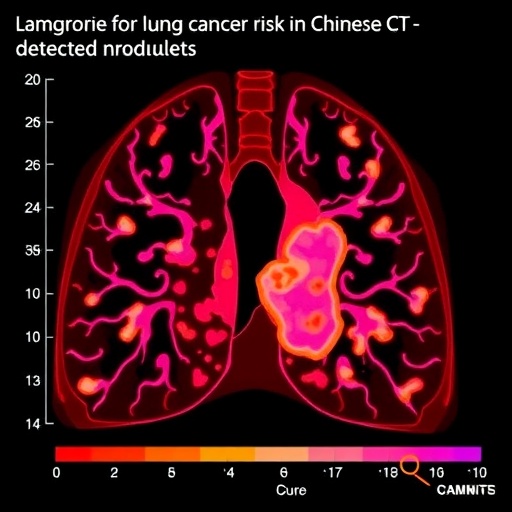
A groundbreaking study from China is reshaping the landscape of lung cancer screening, unveiling a novel predictive model that enhances the accuracy of malignancy assessments for pulmonary nodules detected via low-dose computed tomography (LDCT). Published in BMC Cancer, this research addresses crucial challenges inherent in lung cancer early detection programs, particularly the high rates of false positives and overdiagnosis that undermine the potential life-saving benefits of LDCT screening.
Lung cancer remains the leading cause of cancer-related mortality worldwide, with early detection being paramount for improving survival outcomes. Low-dose computed tomography has emerged as a powerful screening tool capable of identifying pulmonary nodules at their earliest stages. Nevertheless, the clinical dilemma lies in distinguishing which nodules harbor malignancy, as many detected nodules turn out to be benign, leading to unnecessary diagnostic procedures and patient anxiety.
The Chinese research team leveraged data from the Henan province Cancer Screening Program in Urban China (CanSPUC), a robust prospective cohort study enrolling heavy smokers from 2013 through 2021. Among more than 23,000 participants undergoing baseline LDCT screening, over 2,500 individuals were diagnosed with pulmonary nodules. The investigators meticulously gathered comprehensive clinical, behavioral, and radiographic data, followed by longitudinal surveillance, to elucidate patterns predictive of lung cancer development.
.adsslot_NqpuIodyc5{ width:728px !important; height:90px !important; }
@media (max-width:1199px) { .adsslot_NqpuIodyc5{ width:468px !important; height:60px !important; } }
@media (max-width:767px) { .adsslot_NqpuIodyc5{ width:320px !important; height:50px !important; } }
ADVERTISEMENT
Employing multivariable Cox proportional hazards regression analyses, the researchers identified an array of prognostic factors intricately linked to nodule malignancy risk. The resultant model integrated demographic variables such as age and gender, lifestyle elements including physical activity levels and pickled food consumption, alongside medical history factors like silicosis and pneumoconiosis. Crucially, radiological features of the nodules—type, size, calcification status, and the presence of a pleural retraction sign—were pivotal components of the predictive framework.
Performance metrics of the new model are striking. The Area Under the Curve (AUC) values for lung cancer risk prediction at one, three, and five years reached impressive levels of 0.855, 0.844, and 0.863, respectively. These results reflect excellent discrimination capabilities, surpassing established models such as the Mayo, VA, Peking University (PKU), and Brock models, which have long been standards in the field.
Internal validation underscored the model’s robustness, demonstrating reliable calibration across risk deciles and consistent accuracy within diverse subpopulations. However, when externally validated against data from the National Lung Screening Trial (NLST) in the United States, the model exhibited somewhat diminished predictive performance, underscoring the necessity for further validation across more heterogeneous cohorts to cement its generalizability.
The implications of this research are profound. By enabling a precise estimation of lung cancer probability in nodules identified during baseline LDCT scans, clinicians can adopt a more nuanced, risk-adapted approach to patient management. This stratification may reduce unnecessary invasive procedures, optimize resource allocation, and ultimately enhance patient quality of care in lung cancer screening programs.
The inclusion of environmental and occupational exposure variables—specifically silicosis and pneumoconiosis histories—reflects innovative acknowledgment of region-specific risk factors prevalent in China’s industrial demographics. Additionally, dietary habits such as consumption of pickled foods, which may influence pulmonary carcinogenesis, were incorporated, enriching the model’s contextual relevance.
Radiologic characterization remains a cornerstone of risk assessment. The pleural retraction sign, accompanied by nodule morphology and size analysis, provides potent imaging biomarkers indicative of malignant transformation. Integrating these imaging features with clinical data enables a multidimensional risk profile, advancing beyond isolated parameter evaluations.
This study emerges in the context of ongoing debates regarding the balance between LDCT screening benefits and harms. False positives provoke psychological distress and may trigger unnecessary biopsies or surgeries, while overdiagnosis leads to overtreatment of indolent cancers unlikely to affect patient survival. The newly developed model thus promises to refine the risk-benefit calculus inherent in lung cancer screening paradigms.
Interestingly, the model’s superior performance against globally recognized counterparts highlights the necessity for population-specific tools. Differences in genetic backgrounds, environmental exposures, and lifestyle factors mandate tailored approaches to risk prediction, challenging the universality of one-size-fits-all models.
From a methodological perspective, the use of multivariable Cox regression facilitates the temporal analysis of risk, considering time-to-event data and accommodating censored observations inherent in longitudinal cohort studies. This approach ensures that risk estimations reflect dynamic probabilities over clinically meaningful time horizons.
Despite these advancements, the authors prudently emphasize cautious interpretation and advocate for extensive external validations involving broader and more ethnically diverse populations. Such endeavors are vital to affirm predictive stability and facilitate integration into international screening guidelines.
The Henan CanSPUC predictive nomogram represents a significant stride toward precision medicine in lung cancer screening. By stratifying patients according to individualized malignancy risk, it promises to optimize surveillance intervals, enhance shared decision-making, and potentially reduce lung cancer mortality through timely interventions.
As the burden of lung cancer escalates in China due to demographic shifts and persistent tobacco use, this research offers a pragmatic tool to enhance screening efficacy. Policymakers and clinicians are poised to benefit from models that transcend rudimentary assessments and embrace multifactorial risk landscapes.
Moreover, the incorporation of lifestyle data into predictive modeling attests to an evolving recognition of modifiable risk factors, opening avenues for targeted preventive strategies alongside screening. Public health initiatives may leverage these insights to educate high-risk populations about environmental and dietary contributors to lung cancer risk.
Future directions should explore integration with emerging biomarkers and artificial intelligence-driven imaging analytics, potentially augmenting predictive accuracy further. Combined with scalable implementation frameworks, such models could revolutionize early detection on a global scale.
In summary, this pioneering Chinese study delineates a sophisticated, validated predictive model that enhances the precision of lung cancer risk estimation for pulmonary nodules detected by LDCT. It balances clinical, radiographic, and lifestyle factors to produce a versatile tool with substantial potential to improve outcomes in lung cancer screening programs worldwide.
Subject of Research: The development and validation of a predictive model estimating the probability of lung cancer in patients with pulmonary nodules detected via low-dose computed tomography screening.
Article Title: The probability of lung cancer in patients with pulmonary nodules detected via low-dose computed tomography screening in China
Article References:
Guo, LW., Lyu, ZY., Liu, Y. et al. The probability of lung cancer in patients with pulmonary nodules detected via low-dose computed tomography screening in China. BMC Cancer 25, 1058 (2025). https://doi.org/10.1186/s12885-025-14449-6
Image Credits: Scienmag.com
DOI: https://doi.org/10.1186/s12885-025-14449-6
Tags: cancer screening programs in ChinaChinese lung cancer studycomprehensive clinical data analysisearly detection of lung cancerfalse positives in LDCTheavy smokers lung cancer riskHenan province cancer screening researchlow-dose computed tomography screeninglung cancer risk assessmentoverdiagnosis in lung cancerpredictive model for malignancypulmonary nodules detection



